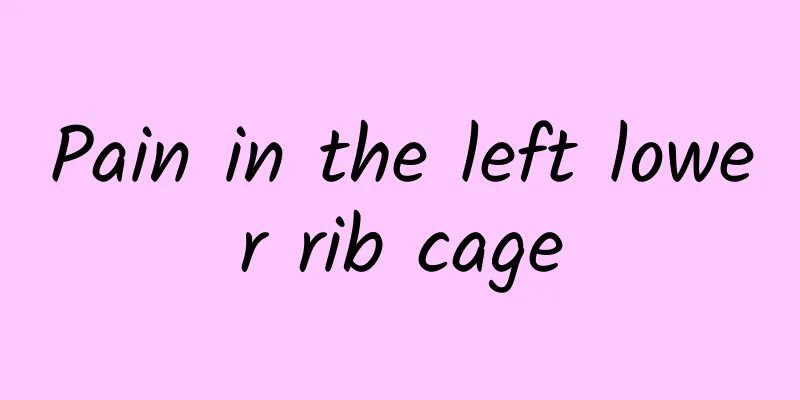Pain in the left lower rib cage

|
Pain inside the rib cage on the lower left side of the chest is one of the most obvious symptoms of costochondritis. Costochondritis is generally divided into two types: one is nonspecific costochondritis and the other is infectious costochondritis. The two types of costochondritis have different clinical manifestations and treatments, but both can be prevented by the same methods. Below, we will introduce in detail the clinical manifestations, treatment methods and prevention methods of costochondritis! 1. Clinical manifestations 1. Nonspecific costochondritis In the early stage of the disease, patients feel chest pain. After a few days, swelling, bulge, dull pain or sharp pain appear in the affected costal cartilage. The site of occurrence is mostly the 2nd to 4th costal cartilage beside the sternum, with the 2nd costal cartilage being the most common, and occasionally it can also occur in the costal arch. This disease often affects a single rib, but occasionally multiple ribs or both sides of the ribs are affected at the same time. There is obvious local tenderness, and the pain radiates to the scapula or side shoulder, upper arm, and armpit of the back. The pain is aggravated by deep breathing, coughing, activity, chest straightening, and fatigue. Acute cases may occur suddenly, with a feeling of stabbing, throbbing or soreness in the chest; insidious cases develop slowly, causing the junction of the ribs and costal cartilage to become bow-shaped, swollen, and dull pain without any changes in the skin. The pain varies in severity and often lingers. Because the lesion is located in the upper part of the breast, there is also referred pain in the breast on the same side, and female patients mistakenly think they have breast pain and seek medical treatment. However, diseases of the breast itself can often be identified by feeling a lump or cord-like object in the breast, or by local redness of the breast skin. The course of the disease may last for several hours or days, but it may relapse and usually heal itself within a few months, but in some cases it may last for several years. 2. Infectious costochondritis The local skin will become red, swollen, hot and painful, with chest pain being the main symptom. Most of the symptoms are of this type first, with varying degrees of severity. Patients are afraid to take deep breaths or cough due to chest pain, which can easily lead to lung infection. Soft tissue necrosis can form abscesses, and rupture of abscesses can form sinus tracts. Patients often have obvious systemic infection symptoms. II. Treatment 1. Nonspecific costochondritis (1) Costochondritis is generally treated only symptomatically, such as taking analgesics, hot compresses, physical therapy, or local blockade with procaine. Systemic or topical administration of corticosteroids may also help relieve symptoms. Erythromycin and morphine can be taken in the acute phase. Give antiviral drugs such as Virulin. Alternatively, you can use hormones such as prednisone or dexamethasone. For those with severe pain, 5 ml of lidocaine plus dexamethasone can be directly injected into the painful area, and local blockade can be performed with novocaine and prednisolone. (2) If the pain fails to be relieved by long-term drug treatment, affects the patient's mood and work, or local malignant tumors cannot be ruled out, costal cartilage resection may be considered. 2. Infectious costochondritis Perform conservative treatment first, use targeted antibiotics to effectively control infection and provide symptomatic analgesia. When the above methods are ineffective, surgical treatment is required. 3. Prevention 1. The occurrence of this disease may be related to upper respiratory tract infection. Therefore, the first step to prevention is to avoid catching a cold. Open windows frequently to ventilate the room. Go to public places less often and participate in more sports activities to enhance your own resistance. Get a flu shot if necessary. 2. Keep warm every day to prevent cold. When you are sweating, you should not take off your clothes immediately to avoid catching a cold. Clothing should be loose and dry. Avoid moisture. Pay attention to the combination of work and rest, and avoid overwork. 3. When working, improve your awareness of protection, use the correct posture when carrying heavy objects, do not use excessive force, and beware of damage to the sternal costal cartilage and ligaments. 4. Eat more vegetables and fruits, and more foods that enhance immunity, such as milk, eggs, fish, etc. 5. Avoid spicy foods such as chili peppers and foods containing large amounts of animal fat, quit smoking (smoking is an important factor in the occurrence of serious complications), and do not drink strong alcohol. |
<<: Pain in lower left rib cage
>>: What is the correct way to boil Chinese medicine in an electric rice cooker?
Recommend
Can pregnant women eat pola collagen powder?
Pola collagen powder is a health product. It has ...
Traditional Chinese medicine's unique skill of regulating health and maintaining health - abdominal massage method that can be used by everyone
Traditional Chinese medicine believes that massag...
How to promote penis development
You all know that the development of children dur...
Wart Cryotherapy
What we commonly call warts are actually a skin d...
Is enema good?
Many friends who suffer from frequent constipatio...
How to make steamed glutinous rice with salted duck eggs
Steaming glutinous rice with salted duck eggs is ...
What is the best way to treat ADHD?
Many people must know what ADHD is. If ADHD is no...
Early symptoms of encephalitis
Encephalitis is a common brain disease in infants...
Can anal sinusitis be cured?
Anal sinusitis has a private location but a great...
Can I eat grapefruit when I have my period?
I believe everyone must be familiar with grapefru...
What to do if your breasts swell when you stop breastfeeding
Women may experience breast pain when weaning. Th...
Side effects of tapping the gallbladder meridian
What kind of disease is acute thyroiditis? Acute ...
Chinese medicine for lowering blood sugar
There are many types of medicines, and you cannot...
Postoperative care for hand injuries
The hand can be said to be the most hardworking o...
Neostigmine methylsulfate effects and uses
Neostilbene methylsulfate is a relatively common ...









